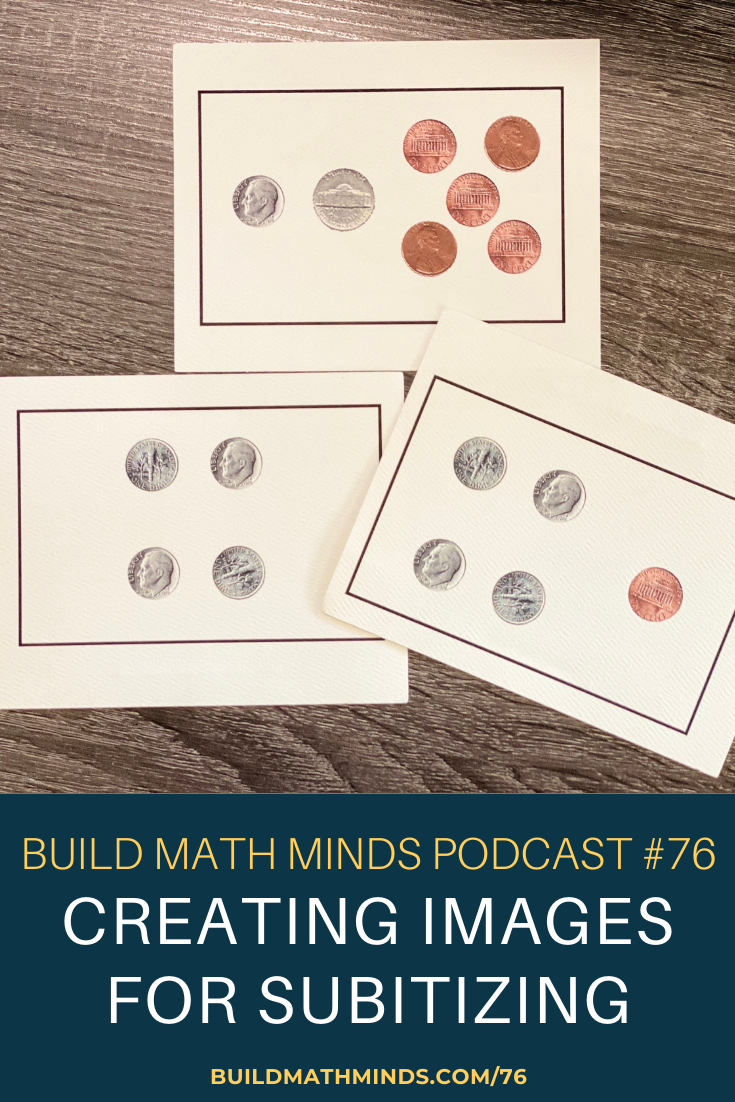Resources mentioned in this episode:
Subitizing: What Is It? Why Teach It? By Douglas Clements
Watch the Building Math Fluency Video Series
Welcome fellow Recovering Traditionalists to Episode 76. Today we are taking a look at tips for Creating Images for Subitizing.
The first time I was introduced to Subitizing was in the article Subitizing: What Is It? Why Teach It? By Douglas Clements. The article was published in 1999, but one thing I discovered through that article was even though the term was fairly new, there had been research done around it from as far back as 1912! Still today we have lots of elementary educators who don’t know what Subitizing is, why it’s important, or how to teach it.
If you aren’t sure what Subitizing is, then pause this video and go download the article. I’ll link to it over at buildmathminds.com/76 and then you can come back and listen to the rest of this episode because what I’d like to chat about today is some advice on how to actually create images to use for subitizing activities.
As I was re-reading this article to find a section to share with all of you, this one section stood out to me as the one to share because I was guilty of not following these guidelines about the types of images we should use with kids. When my own personal kids were around 2 and 3, I started making my own subitizing cards for them. I made ones with turkeys for my son and princesses for my daughter (yeah, I know, wrong in so many ways!). In my mind I was creating images that were things they liked, but I wasn’t following the guidelines Clements lays out in his article.
So for those of you who are creating images for students to subitize here are the four guidelines he lays out on page 403:
“Initially, groups to be subitized should follow these guidelines: (a) groups should not be embedded in pictorial context; (b) simple forms, such as homogeneous groups of circles or squares rather than pictures of animals or mixtures of any shapes, should be used for the units; (c) regular arrangements should be emphasized, and most should include symmetry, with linear arrangements for preschoolers and rectangular arrangements for older students being easiest; and (d) good figure-ground contrast should be used.”
So, keep it simple. All you need are circles or squares and they should not be surrounded by other scenery or embedded in pictures. Start with regular arrangements, like dice patterns and ones with symmetry. Make sure you have a good contrast between the shapes and the background.
That’s it.
To create great subitizing activities for your students, don’t make it more complicated than you need to…right now you’ve got a lot of other complicated things in your work. My two favorite ways to create subiziting images is inside a PowerPoint (or some other kind of presentation slideshow) and just creating a circle that I copy & paste over and over OR I take 3×5 cards and those circle stickers that people use for yard sales and I put the circle stickers on the 3×5 card to make a subitizable arrangement.
Again if you want to read the article by Clements, I’ll link to it at buildmathminds.com/76 and on that page I’ll also link to a free video series I’m doing about helping kids develop fluency in math and the most recent video that was released was all about The Importance of Visuals. Subitizing plays a big role in helping kids use visuals in math so I’d love for you to check out that video. Again, it’s link up for you over at buildmathminds.com/76
Stay safe and stay healthy.
Subscribe and Review in iTunes
Hey, are you subscribed to the Build Math Minds Podcast, yet? If you’re not, make sure to do that today because I don’t want you to miss any episodes! Click here to subscribe to the podcast in iTunes.
While you’re there, don’t forget to leave a review on iTunes too. I would love to know your thoughts and how we can make sure that we give you content that you will really enjoy.
To leave a review, head over to iTunes and click on “Ratings and Reviews” and “Write a Review.” I can’t wait to hear your thoughts about the podcast.





You can also use the Number Frame app from the Math Learning Center. It’s free and great for remote leaning!
Good Info